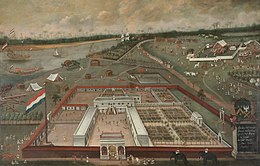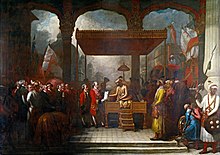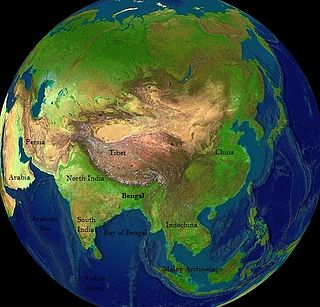
Bengal or endonym Bangla is a historical geographical, ethnolinguistic and cultural term referring to a region in the eastern part of the Indian subcontinent at the apex of the Bay of Bengal. The region of Bengal proper is divided between modern-day Bangladesh and the Indian state of West Bengal. The Indian states of Assam, Jharkhand, Bihar, Chhattishgarh and Tripura as well as the union territory of Andaman and Nicobar islands have a sizeable Bengali population. A large Bengali diaspora exists across the world. Bengali is the sixth-most spoken language in the world.

Dhaka Division is an administrative division within Bangladesh. Dhaka serves as the capital city of the Dhaka Division, the Dhaka District and Bangladesh. The division remains a population magnet, covers an area of 20,508.8 km2 with a population in excess of 44 million, It is the most populous country second level division of the world, growing at 1.94% rate since prior count, compared with national average of 1.22%. However, national figures may include data skewing expatriation of male labor force as gender ratio is skewed towards females.

Murshidabad is a historical city in the Indian state of West Bengal. It is located on the eastern bank of the Bhagirathi River, a distributary of the Ganges. It forms part of the Murshidabad district.

The Bengal Presidency, officially the Presidency of Fort William in Bengal and later Bengal Province, was a province of British India and the largest of all the three Presidencies. At the height of its territorial jurisdiction, it covered large parts of what is now South Asia and Southeast Asia. Bengal proper covered the ethno-linguistic region of Bengal. Calcutta, the city which grew around Fort William, was the capital of the Bengal Presidency. For many years, the Governor of Bengal was concurrently the Governor-General of India and Calcutta was the capital of India until 1911.

The history of Bengal is intertwined with the history of the broader Indian subcontinent and the surrounding regions of South Asia and Southeast Asia. It includes modern-day Bangladesh and the Indian states of West Bengal, Tripura and Assam's Karimganj district, located in the eastern part of the Indian subcontinent, at the apex of the Bay of Bengal and dominated by the fertile Ganges delta. The region was known to the ancient Greeks and Romans as Gangaridai, a powerful kingdom whose war elephant forces led the withdrawal of Alexander the Great from India. Some historians have identified Gangaridai with other parts of India. The Ganges and the Brahmaputra rivers act as a geographic marker of the region, but also connects the region to the broader Indian subcontinent. Bengal, at times, has played an important role in the history of the Indian subcontinent.

The Nawab of Bengal was the hereditary ruler of Bengal Subah in Mughal India. In the early 18th-century, the Nawab of Bengal was the de facto independent ruler of the three regions of Bengal, Bihar and Orissa which constitute the modern-day sovereign country of Bangladesh and the Indian states of West Bengal, Bihar and Odisha. They are often referred to as the Nawab of Bengal, Bihar and Orissa. The Nawabs were based in Murshidabad which was centrally located within Bengal, Bihar, and Odisha. Their chief, a former prime minister, became the first Nawab. The Nawabs continued to issue coins in the name of the Mughal Emperor, but for all practical purposes, the Nawabs governed as independent monarchs. Bengal continued to contribute the largest share of funds to the imperial treasury in Delhi. The Nawabs, backed by bankers such as the Jagat Seth, became the financial backbone of the Mughal court. During the 18th century, the Nawabs of Bengal were among the wealthiest rulers in the world.

Mir Syed Jafar Ali Khan Bahadur was a commander-in-chief or military general who reigned as the first dependent Nawab of Bengal of the British East India Company. His reign has been considered by many historians as the start of the expansion of British control of the Indian subcontinent in Indian history and a key step in the eventual British domination of vast areas of pre-partition India.

Alivardi Khan was the Nawab of Bengal from 1740 to 1756. He toppled the Nasiri dynasty of Nawabs by defeating Sarfaraz Khan in 1740 and assumed power himself.

Dhaka (Dacca) is a modern megacity with origins dating to circa the 7th century CE. The history of Dhaka begins with the existence of urbanised settlements that were ruled by the Hindu Gauda Kingdom, Buddhist and Shaivite Pala Empire before passing to the control of the Hindu Sena dynasty in the 10th century CE. After the Sena dynasty, the city was ruled by the Hindu Deva Dynasty.
Bargis were a light cavalry mercenary group of Maratha Empire's who indulged in large scale plundering of the countryside of western part of Bengal for about ten years (1741–1751) during the Maratha invasions of Bengal. Maratha invasions took place almost as an annual event for 10 years.

Murshid Quli Khan, also known as Mohammad Hadi and born as Surya Narayan Mishra, was the first Nawab of Bengal, serving from 1717 to 1727.
The Maratha invasions of Bengal (1742–1751), also known as the Maratha expeditions in Bengal, were the frequent invasions by the Maratha forces in the Bengal Subah, after their successful campaign in the Carnatic region at the Battle of Trichinopoly. The leader of the expeditions was Raghoji Bhonsle of Nagpur. The Marathas invaded Bengal five times from April 1742 to March 1751, which caused widespread economic losses in the Bengal Subah.
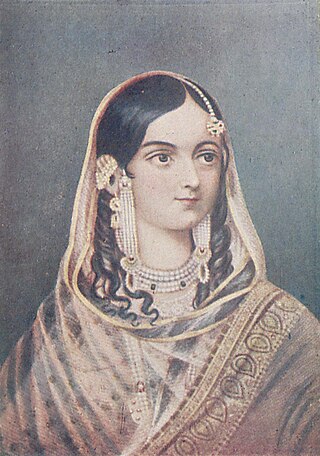
Mehar un-Nisa Begum, better known as Ghaseti Begum, was the eldest daughter of Alivardi Khan, Nawab of Bengal, Bihar and Orissa during 1740–1756.

Mir Habib Isfahani was a warlord who used to be in the employment of the Mughal Subedars (officers) of Bengal, but after being discontent with promotions, went on to aid the Maratha invaders of Bengal and aided in the various Maratha campaigns carried out in Bengal, Bihar, Orissa and adjoining places.
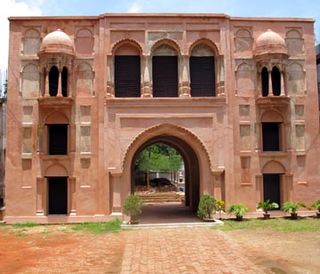
The Naib Nazim of Dhaka, officially the Naib Nazim of Jahangir Nagar, was the chief Mughal political officer in the city of Dhaka, the present-day capital of Bangladesh, between the mid-18th and mid-19th centuries. It was the second highest office in the political hierarchy of Subah of Bengal, including a nominal position during the East India Company's occupation of Bengal.

Amina Begum was a Bengali aristocrat from the Nawab family of Bengal and mother of Siraj ud-Daulah, the last independent Nawab of Bengal.

Nawazish Muhammad Khan, also known as Mirza Muhammad Raza, was a Mughal aristocrat and the deputy governor of Dhaka in the 18th century.
Zain ud-Din Ahmad Khan, also known as Mirza Muhammad Hashim, was an aristocrat from the Nawab of Bengal family and the father of Siraj ud-Daulah, the last independent Nawab of Bengal.
Mīrzā Lutfullāh Khān Tabrīzī, also known as Murshid Qulī Khān II, was an 18th-century administrator who served under the Nawabs of Bengal as the Naib Nazim of Jahangirnagar (Dhaka) and Orissa respectively. Lutfullah was also a calligrapher, as well as an author in the Persian language under the pen name Sarshār.

Mirza Agha Muhammad Baqer was an aristocrat of the Mughal Empire and the Zamindar of Buzurg-Umedpur and Salimabad. In the Mughal period, these two parganas were spread over a large part of the greater Barisal region. Baker was the son-in-law of Murshid Quli Khan II, the Naib Nazim of Orissa under Nawab Sarfaraz Khan. Baqer had an important role in the conflict between Tabrizi and Alivardi Khan regarding the inheritance of Orissa's Naib Nazimate. He also founded the port marketplace of Bakerganj, which later became the headquarters of the Backergunge District. The legendary origin of the Bakarkhani bread is also attributed to him.



